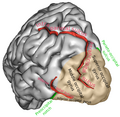| Intraparietal sulcus | |
|---|---|
 Lateral surface of left cerebral hemisphere, viewed from the side. (Intraparietal sulcus visible at upper right, running horizontally.) | |
 Right cerebral hemisphere, viewed from the side. The region colored in blue is parietal lobe of the human brain. Intraparietal sulcus runs horizontally at the middle of the parietal lobe. | |
| Details | |
| Part of | Parietal lobe |
| Identifiers | |
| Latin | sulcus intraparietalis |
| Acronym(s) | IPS |
| NeuroNames | 97 |
| NeuroLex ID | birnlex_4031 |
| TA98 | A14.1.09.127 |
| TA2 | 5475 |
| FMA | 83772 |
| Anatomical terms of neuroanatomy | |
The intraparietal sulcus (IPS) is located on the lateral surface of the parietal lobe, and consists of an oblique and a horizontal portion. The IPS contains a series of functionally distinct subregions that have been intensively investigated using both single cell neurophysiology in primates [1] [2] and human functional neuroimaging. [3] Its principal functions are related to perceptual-motor coordination (e.g., directing eye movements and reaching) and visual attention, which allows for visually-guided pointing, grasping, and object manipulation that can produce a desired effect.
Contents
The intraparietal sulcus (IPS) plays a pivotal role in multisensory integration, particularly in linking visual and tactile information to guide complex motor actions. Beyond its established roles in numerical cognition and spatial attention, the IPS has emerged as a critical player in tool use and manipulation. [4]
The IPS is also thought to play a role in other functions, including processing symbolic numerical information, [5] visuospatial working memory, [6] decision-making, [7] and interpreting the intent of others. [8] [ unreliable medical source? ]

